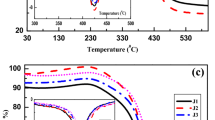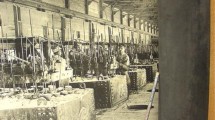Abstract
The effects of CaO, Fe2O3, and MnO2 on the combustion reactivity of anthracite and coal char with low combustibility were investigated using thermogravimetric analysis (TG) and a drop tube furnace (DTF) under an oxygen-rich atmosphere. TG results showed that catalysts exhibited different effects on the combustion characteristics of fuels. For ignition temperature, it was found that, with increasing addition, the ignition temperature first decreased and then increased. For combustion rate, the positive effect of the catalyst on combustion rate was significantly enhanced with the increasing amount of additive. For burnout behaviour, at an equal additive dose, the effects of the three catalysts on burnout behaviour of two fuels varied greatly. The DTF results showed that the combustion reactivity of coal char was improved even more than that of anthracite. Eventually, the effects of three factors, including properties of the catalysts, fuel properties, and combustion conditions, on the catalytic combustion, were discussed.










Similar content being viewed by others
References
Gong X, Guo Z, Wang Z. Reactivity of pulverized coals during combustion catalyzed by CeO2 and Fe2O3. Combust Flame. 2010;157:351–6.
Martins S, Fernandes JB, Mojumdar SC. Catalysed thermal decomposition of KClO3 and carbon gasification. J Therm Anal Calorim. 2014;119:831–5.
Gong X, Guo Z, Wang Z. Variation on anthracite combustion efficiency with CeO2 and Fe2O3 addition by differential thermal analysis (DTA). Energy. 2010;35:506–11.
Sowa JM, Fletcher TH. Investigation of an iron-based additive on coal pyrolysis and char oxidation at high heating rates. Fuel Process Technol. 2011;92:2211–8.
Cui X, Zhang X, Feng Y, Wang G, Yang M, Gao H, Luo W. Effect of partial substitution of Ca in LaMnO3 on coal catalytic combustion. J Therm Anal Calorim. 2013;112:719–26.
Köpsel RFW, Halong S. Catalytic influence of ash elements on NOx formation in char combustion under fluidized bed conditions. Fuel. 1997;76:345–51.
Skowroński JM. Study of graphite-manganese oxide catalysts via modified DTA curves. J Therm Anal. 1983;27:69–76.
Li XG, Ma BG, Xu L, Luo ZT, Wang K. Catalytic effect of metallic oxides on combustion behavior of high ash coal. Energy Fuels. 2007;21:2669–72.
Ma BG, Li XG, Xu L, Wang K, Wang XG. Investigation on catalyzed combustion of high ash coal by thermogravimetric analysis. Thermochim Acta. 2006;445:19–22.
Zhang LM, Tan ZC, Wang SD, Wu DY. Combustion calorimetric and thermogravimetric studies of graphite and coals doped with a coal-burning additive. Thermochim Acta. 1997;299:13–7.
Fangxian L, Shizong L, Youzhi C. Thermal analysis study of the effect of coal-burning additives on the combustion of coals. J Therm Anal Calorim. 2009;95:633–8.
Gopalakrishnan R, Bartholomew C. Effects of CaO, high-temperature treatment, carbon structure, and coal rank on intrinsic char oxidation rates. Energy Fuels. 1996;10:689–95.
Fan D, Zhu Z, Na Y, Lu Q. Thermogravimetric analysis of gasification reactivity of coal chars with steam and CO2 at moderate temperatures. J Therm Anal Calorim. 2013;113:599–607.
Saint-Just J, Der Kinderen J. Catalytic combustion: from reaction mechanism to commercial applications. Catal Today. 1996;29:387–95.
He XM, Qin J, Liu RZ, Hu ZJ, Wang JG, Huang CJ, Li TL, Wang SJ. Catalytic combustion of inferior coal in the cement industry by thermogravimetric analysis. Energy Sources Part A. 2013;35:1233–40.
Kakaras E, Vourliotis P. Coal combustion with simulated gas turbine exhaust gas and catalytic oxidation of the unburnt fuel. Fuel. 1998;77:1357–65.
Levendis YA, Nam SW, Lowenberg M, Flagan RC, Gavalas GR. Catalysis of the combustion of synthetic char particles by various forms of calcium additives. Energy Fuels. 1989;3:28–37.
Tan Z, Wang S, Li L, Wu D. Thermogravimetric study about the accelerating effect of coal-burning additive on combustibility of coal and gangue. China J Catal. 1999;20:263–6.
Pei P, Wang D, Wu D. Application of regenerative high temperature air combustion technology on low-rank coal pyrolysis. Energy Procedia. 2015;66:205–8.
Ye J, Liu S, Lü Y. Influence of pyrolysis temperature on the formation of semicoke and its elemental composition. Coal Convers. 2006;29:37–40.
Du S, Chen W, Lucas JA. Pulverized coal burnout in blast furnace simulated by a drop tube furnace. Energy. 2010;35:576–81.
Borrego AG, Osório E, Casal MD, Vilela ACF. Coal char combustion under a CO2-rich atmosphere: implications for pulverized coal injection in a blast furnace. Fuel Process Technol. 2008;89:1017–24.
Gupta S, Sahajwalla V, Al-Omari Y. Influence of carbon structure and mineral association of coals on their combustion characteristics for pulverized coal injection (PCI) application. Metall Mater Trans B. 2006;27:457–73.
Osório E, De Gomes MLI, Vilela ACF, Kalkreuth W, De Almeida MAA, Borrego AG, Alvarez D. Evaluation of petrology and reactivity of coal blends for use in pulverized coal injection (PCI). Int J Coal Geol. 2006;68:14–29.
Gong X, Guo Z, Wang Z. Variation of char structure during anthracite pyrolysis catalyzed by Fe2O3 and its influence on char combustion reactivity. Energy Fuels. 2009;23:4547–52.
Tomita A. Catalysis of carbon–gas reactions. Catal Surv Jpn. 2001;5:17–24.
Zou C, Wen L, Zhang S, Bai C, Yin G. Evaluation of catalytic combustion of pulverized coal for use in pulverized coal injection (PCI) and its influence on properties of unburnt chars. Fuel Process Technol. 2014;119:136–45.
Chen Y, Mori S, Pan W. Studying the mechanism of ignition of coal particles by TG-DTA. Thermochim Acta. 1996;275:149–58.
Gong X, Guo Z, Wang Z. Effect of K2CO3 and Fe2O3 on combustion reactivity of pulverized coal by thermogravimetry analysis. J Fuel Chem Technol. 2009;37:42–8.
McKee DW. Mechanisms of the alkali metal catalysed gasification of carbon. Fuel. 1983;62:170–5.
Xu Y, Hu B. Influence of CeO2 and La2O3 as Additives on burning process of pulverized coal injection into blast furnace. Chin Rare Earths. 2005;26:56–8.
Kevin DA, Robert HH, Nancy YCY, Thomas JH. Evolution of char chemistry, crystallinity, and ultrafine structure during pulverized-coal combustion. Combust Flame. 1995;100:31–40.
Gong X, Guo Z, Wang Z. Anthracite combustion catalyzed by Ca–Fe–Ce series catalyst. J Fuel Chem Technol. 2009;37:421–6.
Wei Y, Chen M, Niu S, You X, Xue F. Evaluation on oxy-fuel co-combustion behavior of Chinese lignite and eucalyptus bark. J Therm Anal Calorim. 2016;56:1667–84.
Acknowledgements
The authors thank The Natural Science Foundation Project of China (Nos. 51374166 and 51574189), The Natural Science Foundation research project, Shanxi, China (No. 2016JQ5041), and The Initial Foundation Project of Xi’an University of Architecture and Technology (No. DB04146) for funding this research.
Author information
Authors and Affiliations
Corresponding author
Rights and permissions
About this article
Cite this article
Zou, C., Zhao, J., Li, X. et al. Effects of catalysts on combustion reactivity of anthracite and coal char with low combustibility at low/high heating rate. J Therm Anal Calorim 126, 1469–1480 (2016). https://doi.org/10.1007/s10973-016-5806-y
Received:
Accepted:
Published:
Issue Date:
DOI: https://doi.org/10.1007/s10973-016-5806-y




